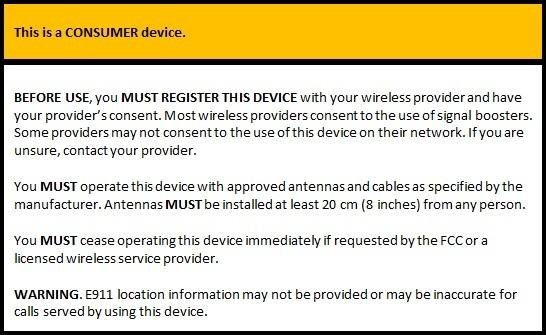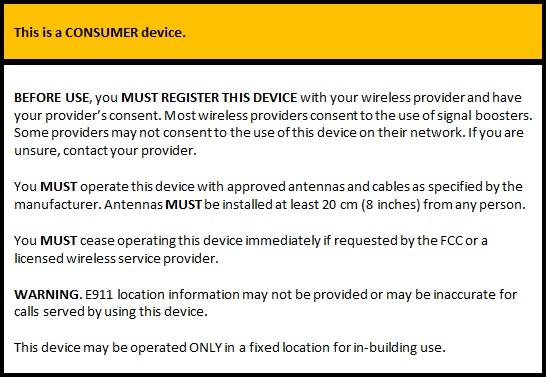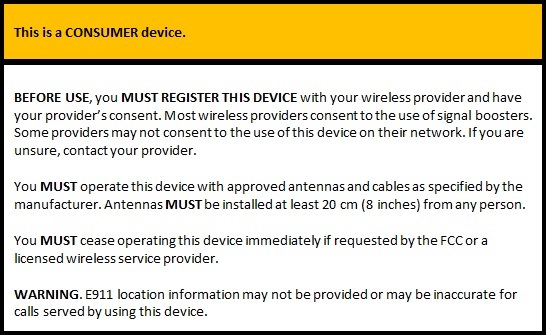Consumers
Consumer Signal Boosters are designed to be used “out of the box” by individuals to improve their wireless coverage within a limited area such as a home, car, boat, or recreational vehicle. The FCC recently adopted new rules to improve signal booster design so these devices won’t cause interference to wireless networks. The FCC also adopted new rules about what cell phone users need to do before using a signal booster. Learn about these new requirements in the Signal Boosters FAQ.
The FCC’s new rules affect you whether you currently own a signal booster or are thinking about purchasing one. There are two things you need to do in order to use a booster:
- Get approval from your wireless provider and
- Register the specific booster with your wireless provider.
Many wireless providers, including AT&T, Sprint, T–Mobile, Verizon, and many others, have agreed to allow the operation of consumer signal boosters that meet the FCC’s new rules.
If the booster has this label (all consumer boosters sold after March 1, 2014, and some sold prior will have this label):

- Verify that your provider has given permission (e.g., AT&T, Sprint, T–Mobile, Verizon) , or else get permission from your wireless provider to use it.
- Register your booster with your wireless provider before turning it on. Each wireless provider that gives permission for boosters to be used must provide a free registration system.
Note: Verizon Wireless, AT&T, Sprint, and T–Mobile have approved all boosters that contain the label, so you do not need to get approval again.
If the booster does not have this label

- Get permission from you wireless provider to use it.
- Register your booster with your wireless provider before turning it on. Each wireless provider that gives permission for boosters to be used must provide a free registration system.
Information needed to register your booster
At a minimum, wireless providers must collect:
- the name of the Consumer Signal Booster owner and/or operator, if different individuals;
- the make, model, and serial number of the device;
- the location of the device; and
- the date of initial operation.
More information is available on the signal boosters FAQ page.
Manufacturers
Signal Boosters certified by the FCC after February 20, 2013, must comply with the new rules. In addition, equipment that is sold and marketed in the United States must meet the FCC’s new requirements as of March 1, 2014. Learn about these new rules and other new requirements.
Transition Process
The FCC established a two-step transition process for equipment certification for Consumer Signal Boosters sold and marketed in the United States.
- As of February 20, 2013, the FCC will no longer accept applications for equipment certification for Consumer Signal Boosters that do not comply with the FCC’s new rules. In addition, the FCC will cease certification of devices which do not comply with the new rules.
- As of March 1, 2014, all Consumer Signal Boosters sold and marketed in the United States must meet the FCC’s new rules.
Network Protection Standard
A consumer’s authorization to use a Consumer Signal Booster is contingent on use of a device that meets all aspects of the FCC’s Network Protection Standard. The Network Protection Standard is a series of technical safeguards designed to minimize the potential for Consumer Signal Boosters to cause interference to wireless networks.
Under the Network Protection Standard, all Consumer Signal Boosters must:
- comply with existing technical parameters for the applicable spectrum band of operation;
- automatically self-monitor certain operations and shut down if not in compliance with our new technical rules;
- automatically detect and mitigate oscillations in the uplink and downlink bands;
- power down or shut down automatically when a device is not needed, such as when the device approaches the base station with which it is communicating;
- be designed so that these features cannot be easily defeated; and
- incorporate interference avoidance for wireless subsystems.
Specifications to Satisfy the Network Protection Standard Requirements
The FCC’s rules include two technical specifications for manufacturers of Consumer Signal Boosters to satisfy the requirements of the Network Protection Standard. One set of specifications applies to Wideband Consumer Signal Boosters and the other set of specifications applies to Provider-Specific Consumer Signal Boosters.
Wideband Consumer Signal Boosters
Wideband Consumer Signal Boosters are defined as boosters that may operate on the frequencies and in the market areas of multiple licensees. Because Wideband Consumer Signal Boosters operate across multiple bands and in spectrum licensed to multiple wireless providers, these devices require tight technical specifications to ensure they do not cause harmful interference in adjacent bands.
The technical specifications for Wideband Consumer Signal Boosters contain detailed technical specifications relating to noise limits, bidirectional capability, booster gain limits, power limits, out of band emissions limits, intermodulation limits, antenna kitting, transmit power off mode, and uplink inactivity for Wideband Consumer Signal Boosters. The Wideband Consumer Signal Booster technical specifications also address anti-oscillation, gain control, and interference avoidance for wireless subsystems. These technical specifications are endorsed by the four largest nationwide providers and over 90 small rural providers across the United States, who conclude that signal boosters meeting these specifications will not cause harmful interference to wireless networks.
Provider-Specific Consumer Signal Boosters
Provider-Specific Consumer Signal Boosters are defined as boosters that can only operate on the frequencies and in the market areas of the licensee(s) specified during the certification of the device. These devices are designed to operate only on a particular licensee(s)’s frequencies and in that licensee(s)’s market areas. Provider-Specific Consumer Signal Boosters may be certificated and operated only with the consent of the licensee(s) whose frequencies are being amplified by the device. Any application for certification of a Provider-Specific Consumer Signal Booster must include a certification, made under penalty of perjury,[1] that the applicant has received the consent of the relevant licensee(s) to manufacture the device. Absent this certification, the FCC will not approve an application under our Provider-Specific Consumer Signal Booster technical specifications.
The technical specifications for Provider-Specific Consumer Signal Boosters contains detailed technical specifications relating to noise limits, bidirectional capability, booster gain limits, power limits, out of band emissions limits, intermodulation limits, antenna kitting, transmit power off mode, and uplink inactivity for Provider-Specific Consumer Signal Boosters. The Provider-Specific Consumer Signal Booster technical specifications also address anti-oscillation, gain control, and interference avoidance for wireless subsystems. These technical specifications are endorsed by the four largest nationwide providers and over 90 small rural providers across the United States, who conclude that signal boosters meeting these specifications will not cause harmful interference to wireless networks.
Equivalent Protections to Meet the Network Protection Standard
Any Consumer Signal Booster which does not meet the technical parameters enumerated in the FCC’s rules can still satisfy the Network Protection Standard if the manufacturer can demonstrate that the booster provides equivalent protections. Any entity seeking to certify a Consumer Signal Booster which does not meet the enumerated safeguards contained in the Network Protection Standard may request a determination of “equivalent protection” from the Wireless Telecommunications Bureau. Such requests will be placed on Public Notice and interested parties will have an opportunity to comment. If the Wireless Telecommunications Bureau determines that the proponent has shown equivalent protection that satisfies the Network Protection Standard, the proponent may then seek equipment certification.
Labeling Requirements
Consumer Signal Boosters must include a label to reflect that they:
- are suitable for consumer use;
- must be registered with and authorized by the operator’s wireless provider;
- must be used with manufacturer-specified antenna, cables, and/or coupling devices;
- must be shut down if causing interference; and
- may affect location accuracy of E911 calls.
Here is a sample label for Consumer Signal Boosters:
It is possible that the warning label looks different than the sample label below. However, the warning label must include the same information.
Wireless Providers
Signal Boosters may only be operated with the permission of wireless providers. Many wireless providers, including AT&T, Sprint, T–Mobile, Verizon, and many others, have agreed to allow the operation of consumer signal boosters that meet the FCC’s new rules. In addition, wireless providers need to provide a method for signal boosters to be registered by consumers before the signal boosters can be used. Learn about this process and other important information.
Consenting to the use of Consumer Signal Boosters
A subscriber must have the consent of a wireless provider to operate a Consumer Signal Booster. Subscribers may obtain provider consent in a variety of ways. For example, AT&T, Sprint, T–Mobile, and Verizon Wireless have voluntarily committed to allow their subscribers to use properly certificated Consumer Signal Boosters (i.e., boosters that meet the new rules) on their networks. Also, a signal booster manufacturer could seek authorization for use of a particular booster model on behalf of all subscribers of individual providers. Alternatively, a provider may specify a testing protocol that if satisfied would result in licensee consent to specific booster models. A subscriber may also seek a licensee’s express consent to operate a signal booster, e.g., by phone call or e-mail.
Registering Consumer Signal Boosters
By March 1, 2014, all wireless providers who voluntarily consent to the use of Consumer Signal Boosters on their networks must have established a free registration mechanism for their subscribers. Consumers who purchase wireless service from resellers must also register their boosters. Wireless providers must therefore establish a process for these consumers to register either directly with the serving provider (i.e., the underlying facilities-based provider) or with the applicable reseller.
At a minimum, wireless providers must collect:
- the name of the Consumer Signal Booster owner and/or operator, if different individuals;
- the make, model, and serial number of the device;
- the location of the device; and
- the date of initial operation.
Wireless providers may determine how to collect such information and how to keep it up–to–date. Providers that have not consented to the use of any Consumer Signal Boosters by March 1, 2014, must establish a free registration mechanism for their subscribers within 90 days of consenting to such use.